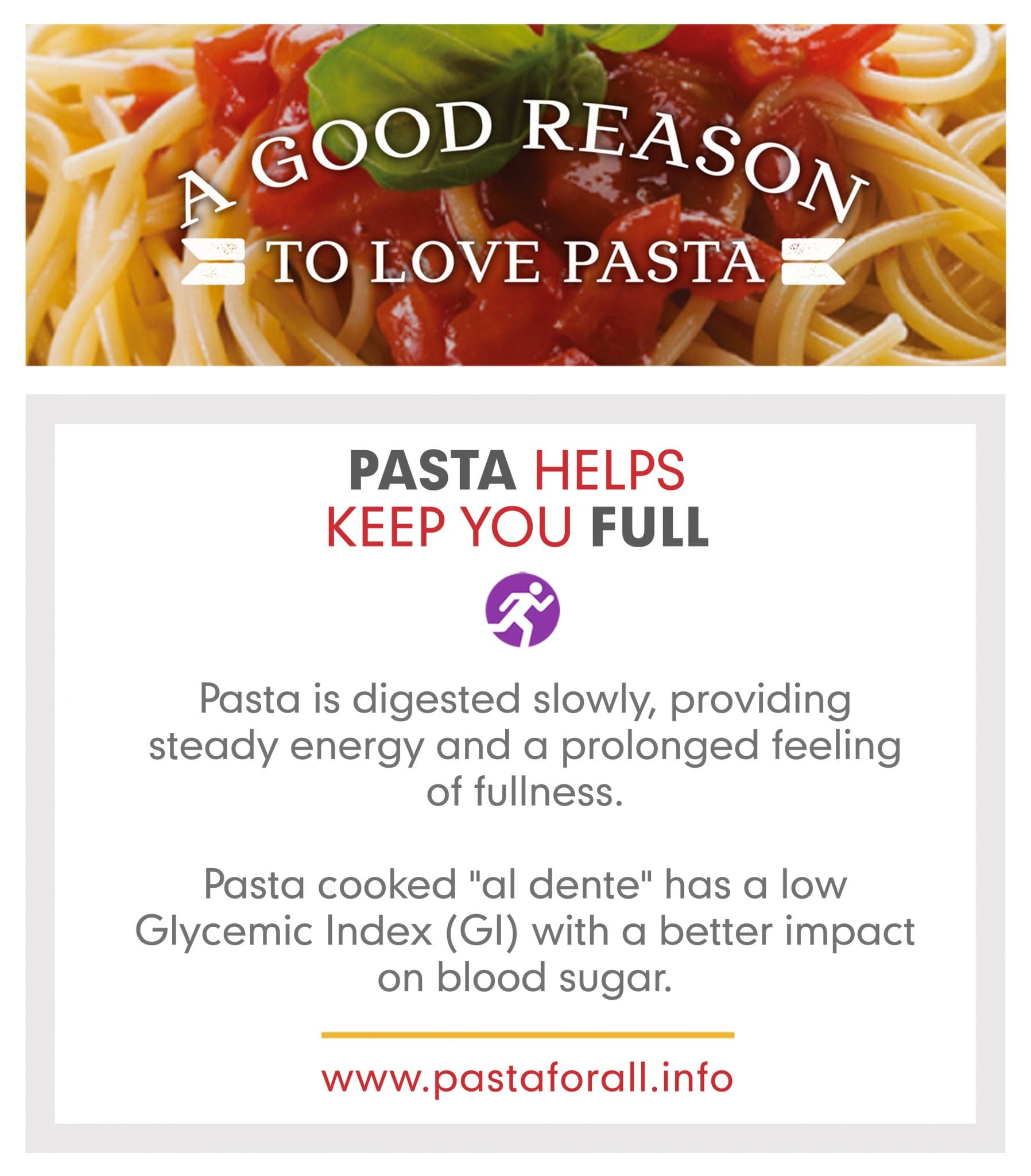- Because the starch present in pasta is digested very slowly, it provides the prolonged feeling of fullness or satiety familiar to all pasta lovers.
- At a time when obesity and diabetes are rising around the world, pasta meals and other low-glycemic foods may help control blood sugar and weight especially in overweight people. Glycemic index (GI) is one of many factors that impact the healthfulness of foods. [1]
- The best foods for glucose metabolism and for health – like pasta cooked “al dente,” vegetables and fruit – have a low GI (less than 55). [2] Surprisingly, pasta has a lower GI than oatmeal and quinoa.
- Pasta has a low GI due to the way it’s made. Extruded durum pasta has a dense matrix that is less permeable even after cooking than other foods like durum bread or grits. This extrusion process leads to denser pastas, which are less susceptible to digestive enzymes and have a lower GI. They are also digested more slowly than sheeted pastas. From its bulk, extruded pasta is more satiating and less glycemic. [3]
- According to Furio Brighenti, Professor and Chair of Human Nutrition at the Department of Food Science, who currently serves as Deputy-Rector for Research of the University of Parma, Italy, “Pasta’s processing makes it a unique food. The processing actually reduces the starch digestibility and thus the glycemic response of its base ingredient, durum wheat semolina. Pasta has a lower glycemic index than the wheat it is made from.”
- Another benefit is that eating pasta at one meal lowers blood glucose and insulin responses at the next meal. Pasta has the potential to satisfy flavor buds and provide a sense of fullness so that less is eaten at the subsequent meal. [4]
- Science shows that when pasta is eaten with other healthy foods like tomatoes, olive oil and cheese the GI is even lower so the feeling of fullness lasts even longer.[5] By virtue of their slow rate of digestibility and absorption, carbohydrate foods with a low glycemic index and glycemic load, such as pasta, consumed within an otherwise healthy eating pattern, may provide a strategy to prevent and manage chronic diseases such as type 2 diabetes and coronary heart disease (CHD).[6]
- At the Scientific Consensus Summit on Glycemic Index, Glycemic Load, & Glycemic Response, in Stresa, Italy in 2013, Salwa Rizkalla of the University Pierre et Marie Curie, in Paris, France, explains that “it is important after eating to feel satiated and full, and not to eat more, to control our energy intake,” and recommends “low glycemic index foods that do not give us the sensation of hunger.”
- Because pasta helps keep you full it is an ideal part of any sports enthusiast’s diet. Ruslan Nigmatullin, a speaker at the 2016 World Pasta Day conference in Moscow and former goalkeeper of the Russian national team, said, “Pasta is the perfect combination of all the necessary elements for an athlete – carbohydrates and protein. But in addition pasta is truly delicious.”
- Similarly, Dr. Jennie-Brand Miller of the University of Sydney, emphasizes the “quality of the carbohydrate,” recommending carbohydrate foods that digest slowly. Luckily, traditional pasta meals fit the bill. In fact, research shows that eating pasta produces a low glycemic response, not only at that meal, but also at the following meal, in a phenomenon known as the ‘second meal concept ‘.
[1]http://oldwayspt.org/sites/default/files/OW_PastaConsensusRio_4lang.pdf
[2]http://oldwayspt.org/programs/special-custom-programs/glycemic-index-scientific-consensus2013
[3]http://oldwayspt.org/resources/good-food/pasta-unique-grain-food-webinar
[4]http://oldwayspt.org/resources/good-food/pasta-unique-grain-food-webinar
[5]http://www.internationalpasta.org/resources/WPD2014/25_10_2014_WPD_2014_Buenos_Aires_Pasta_Glycemic_Index_and_Health_Cyril_W_C_Kendall.pdf
[6]http://www.internationalpasta.org/resources/WPD2014/25_10_2014_WPD_2014_Buenos_Aires_Pasta_Glycemic_Index_and_Health_Cyril_W_C_Kendall.pdf
Back to 5 Good Reasons to Love Pasta





